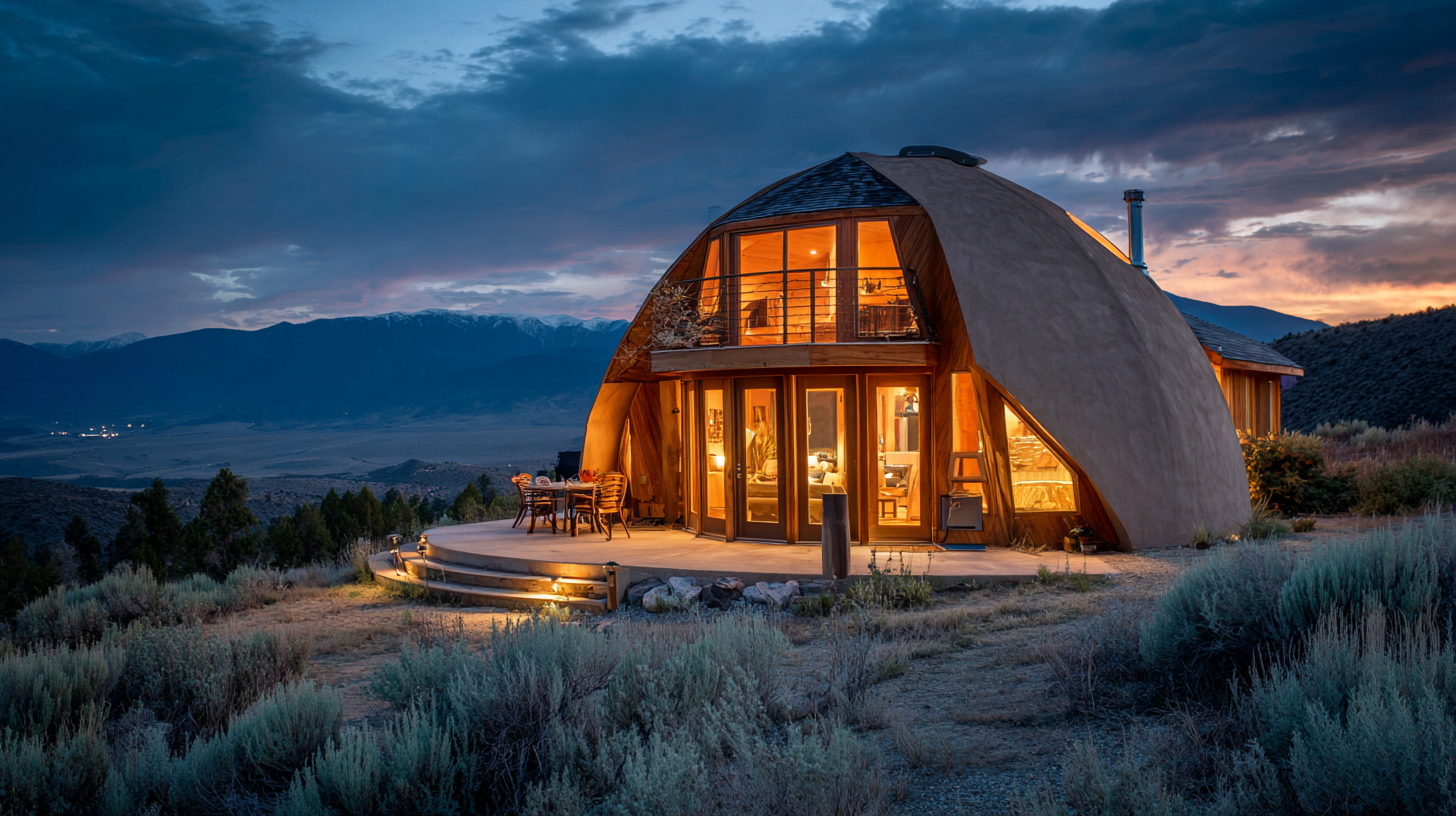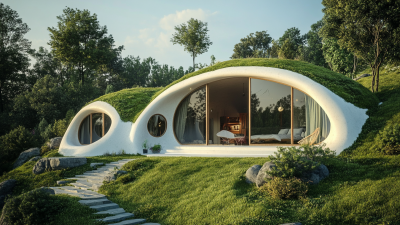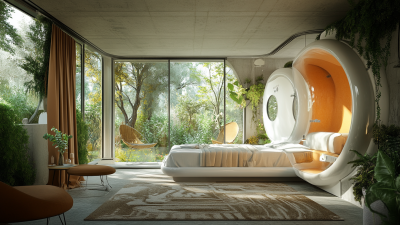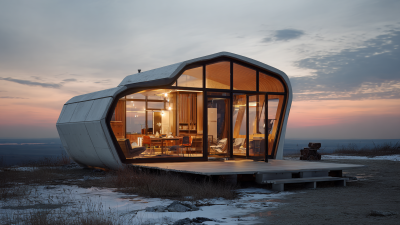
News
How to Optimize Energy Efficiency in Your Dome House Using Innovative Design Strategies
The growing demand for sustainable living spaces has led to an increasing interest in innovative architectural designs, particularly the Dome House. Characterized by its unique structure, a Dome House can lead to significant energy efficiency improvements. According to the U.S. Department of Energy, buildings account for nearly 40% of total energy consumption, making energy-efficient designs paramount in combating climate change. Research shows that structures with curved surfaces, such as dome-shaped buildings, can reduce material usage and minimize thermal bridging, resulting in lower heating and cooling costs. Innovative design strategies, including passive solar heating and natural ventilation, can further enhance the energy efficiency of Dome Houses. By optimizing these features, homeowners can significantly reduce their carbon footprint while promoting a sustainable lifestyle that aligns with modern environmental goals. This article will explore effective design techniques to achieve optimal energy efficiency in Dome Houses, ensuring they remain a viable option for eco-conscious living.

Innovative Insulation Techniques for Dome Houses
Innovative insulation techniques are crucial for optimizing energy efficiency in dome houses, particularly as architects and builders explore sustainable methods for construction. One notable advancement is the integration of bioconstruction materials, such as soil mixed with seeds, which not only provide structural integrity but also contribute to energy savings by enhancing natural insulation qualities. This method not only minimizes waste but also encourages biodiversity, creating a living environment that is both eco-friendly and aesthetically pleasing.
Additionally, the use of advanced insulation systems, such as those found in the innovative 3D-printed homes recently developed in Italy, showcases how modern technology can improve energy efficiency in dome structures. These homes utilize sustainable materials that are tailored to create a controlled indoor climate, reducing the reliance on heating and cooling systems. The continuing evolution of dome house design, combining traditional architectural principles with cutting-edge techniques, exemplifies the potential for creating energy-efficient dwellings that harmonize with the environment.
How to Optimize Energy Efficiency in Your Dome House Using Innovative Design Strategies
| Insulation Technique | Material Used | R-Value | Energy Savings (%) |
|---|---|---|---|
| Spray Foam Insulation | Polyurethane Foam | 6.5 | 30-50% |
| Rigid Foam Board | Extruded Polystyrene | 5.0 | 20-40% |
| Cellulose Insulation | Recycled Paper | 3.7 | 20-35% |
| Reflective Radiant Barrier | Aluminum Foil | Varies | 10-30% |
| Straw Bale Insulation | Straw Bales | 3.0 | 25-40% |
Maximizing Natural Light with Strategic Window Placement
Strategically placing windows can significantly enhance the energy efficiency of dome houses while maximizing natural light. In arid environments, where thermal comfort is crucial, the design of windows should prioritize both ventilation and sunlight intake. Large windows facing the sun can harness daylight, reducing the need for artificial lighting and heating during the day. Coupled with proper shading devices, these windows can minimize glare and prevent excessive heat buildup, thus maintaining a comfortable indoor climate.
Additionally, integrating natural ventilation systems can improve air quality while optimizing energy use. By allowing fresh air to circulate through strategically positioned openings, dome houses can achieve an effective balance between temperature regulation and energy consumption. Incorporating features like operable windows enables occupants to control airflow based on their comfort level, enhancing the overall living experience. Implementing these innovative design strategies not only contributes to a sustainable living environment but also elevates the aesthetic appeal of the home by fostering a connection with the outdoors.

Incorporating Renewable Energy Sources into Dome Designs
 Incorporating renewable energy sources into dome designs not only enhances energy efficiency but also aligns with global sustainability goals. According to the International Renewable Energy Agency (IRENA), renewable energy could account for over 86% of global power demand by 2050 if integrated effectively into modern architecture. Dome houses, with their unique aerodynamic shapes and structural integrity, can greatly benefit from solar panel installations. A well-positioned solar system can capture sunlight efficiently, potentially reducing reliance on conventional energy sources by up to 80%.
Incorporating renewable energy sources into dome designs not only enhances energy efficiency but also aligns with global sustainability goals. According to the International Renewable Energy Agency (IRENA), renewable energy could account for over 86% of global power demand by 2050 if integrated effectively into modern architecture. Dome houses, with their unique aerodynamic shapes and structural integrity, can greatly benefit from solar panel installations. A well-positioned solar system can capture sunlight efficiently, potentially reducing reliance on conventional energy sources by up to 80%.
Moreover, integrating geothermal heating and cooling systems can significantly enhance the overall energy efficiency of dome homes. The U.S. Department of Energy reports that geothermal systems can achieve 300% to 600% efficiency while offering a reliable year-round temperature regulation solution. When combined with natural ventilation strategies and high-performance insulation, these renewable technologies can transform dome houses into self-sufficient living spaces that reduce their carbon footprint and energy consumption. Adopting these innovative design strategies not only promotes energy conservation but also fosters a sustainable lifestyle.
Using Sustainable Materials for Enhanced Energy Efficiency
Sustainable materials play a crucial role in enhancing energy efficiency in dome houses. According to the U.S. Green Building Council, buildings made with sustainable materials can reduce energy usage by up to 30%. By incorporating materials such as straw bales, bamboo, and recycled steel, homeowners can create structures that not only minimize energy consumption during their lifecycle but also reduce carbon footprints. For instance, straw bales provide exceptional insulation, significantly lowering heating and cooling costs, while bamboo’s rapid renewability allows it to be a viable alternative to traditional hardwoods.
Innovative design strategies align perfectly with these sustainable materials to optimize energy efficiency. For example, using reflective roofing materials can enhance natural cooling, reducing reliance on artificial air conditioning. The Passive House Institute highlights that designs integrating thermal mass—such as earth berms or concrete slabs—can store heat during the day and release it at night, further decreasing energy demands. Combined with carefully selected sustainable materials, these design considerations ensure that dome houses not only meet energy standards but exceed them, paving the way for a more sustainable future in residential architecture.
Designing for Passive Heating and Cooling in Dome Structures
Designing dome structures with a focus on passive heating and cooling can significantly enhance energy efficiency. Dome houses inherently benefit from their geometric shape, which allows for optimal airflow and temperature regulation. According to the Department of Energy, homes designed with passive solar principles can reduce heating and cooling energy costs by up to 50%. The curved surface of a dome minimizes surface area, which can lead to reduced heat loss in winter and diminished heat gain in summer, creating a more stable internal climate.
To further enhance passive heating and cooling, strategic placement of windows and thermal mass materials is essential. South-facing windows can harness solar gain while overhangs can provide shade during warmer months. A study from the National Renewable Energy Laboratory indicates that using thermal mass to store heat during the day and release it at night can lower indoor temperature fluctuations by over 20%. Additionally, integrating natural ventilation techniques, such as strategically placed vents or operable windows, can promote air circulation, reducing the need for mechanical cooling systems and contributing to a sustainable living environment.
Energy Efficiency Metrics in Dome Houses
Related Posts
-

How to Source the Perfect Dome House for Sustainable Living Solutions
-

Innovative Solutions for Sustainable Living with Dome House Designs
-

7 Amazing Reasons to Choose a Dome House for Your Next Home
-

Innovative Dome House Designs Transforming Sustainable Living Spaces in Modern Architecture
-

Essential Insights for Global Buyers on Capsule House Europe Innovation Trends and Market Growth
-

7 Innovative Ways a Modular Space House Can Transform Your Living Experience
